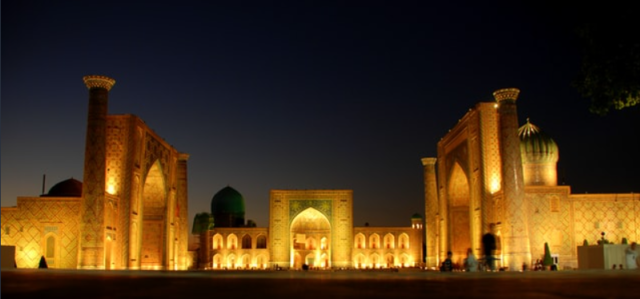SAMARKAND

Click to return to previous city…. DUNHUANG
Samarkand situated in today’s Uzbekistan, was one of the most important links in the Silk Road network in Central Asia. It was at the crossroads of cultures for over two and a half millennia. Located in the Zerafshan River valley, in the North East of Uzbekistan. It was first settled in 1500 BC, and its abundant natural resources made it attractive for settlement. It was conquered by Alexander the Great in 329 BC.
This city, well known for its abundant craft production was the centre of what was then called Sogdia where the Sogdians lived and traded. Starting during the Han Empire (206 BC till 220 AD) Chinese scribes wrote about the Sogdian traders, which gives us material proof of their existence and trading skills. Letters dated to 313-314 AD provide evidence of the Sogdian colonies established along the route, all the way to China. Sogdian inscriptions on rocks in Pakistan (today’s name) prove they were trading with India and later on in the 6th C. AD Sogdian merchants travelled West and developed trade with Byzantium. Given its international nature, Samarkand was a place were Christian and Zoroastrian religions were practiced. Buddhism, Hinduism and Manichaeism were also found to be very present.
In the 8th C. AD the Muslims invaded and took over the city, which caused the Sogdian rulers to flee. After that, Transoxiana became a major learning centre for Muslim teaching under the Persian Samanids. Parts of the city were destroyed, even though the great Arabic traveller, Ibn Battuta, who visited Samarkand described it as the “one of the finest and greatest cities and the most perfect in beauty”.
Traded items:
Major traded items were precious metals, spices and cloth.
Click to proceed to next city…. BUKHARA
A VERY SHORT READING LIST FOR THE SILK ROAD (AND BOOKS USED FOR THE WEBSITE) 11/12/2020
- “Lords of the Horizons – A History of the Ottoman Empire”, by Jason Goodwin. Vintage. 1998
- “The Silk Road – A New History”, by Valerie Hansen. OUP 2012
- “Introduction to Byzantium, 602 -1453”, by Jonathan Harris. Routledge. 2020
- “The Silk Road – A very short Introduction”, by James A. Millward. OUP. 2013
- SERKIS, Christiane. Des Fondateurs de Religions; de certaines langues antiques. Lausanne 2020 Article inédit.
- “Life Along the Silk Road”, by Susan Whitfield. UCal Press 2015
- “Silk Roads – Peoples, Cultures, Landscapes”, Edited by Susan Whitfield. Thames and Hudson. 2019
- www.ChinaHighlights.com/silkroad/history
Tap Star image below to select
next location.
Visits: 76

